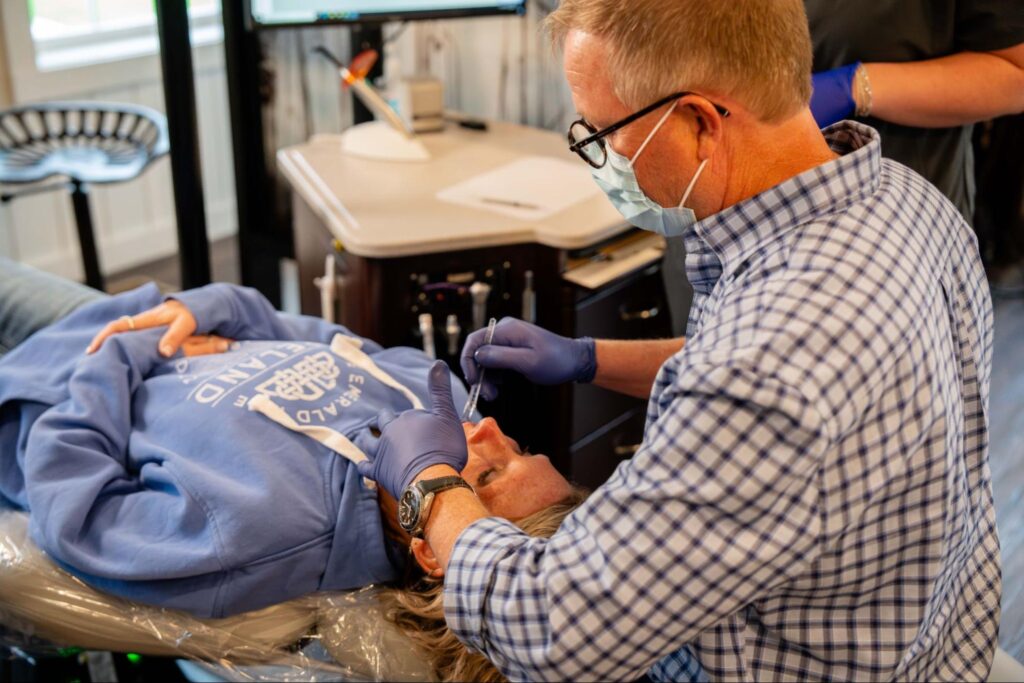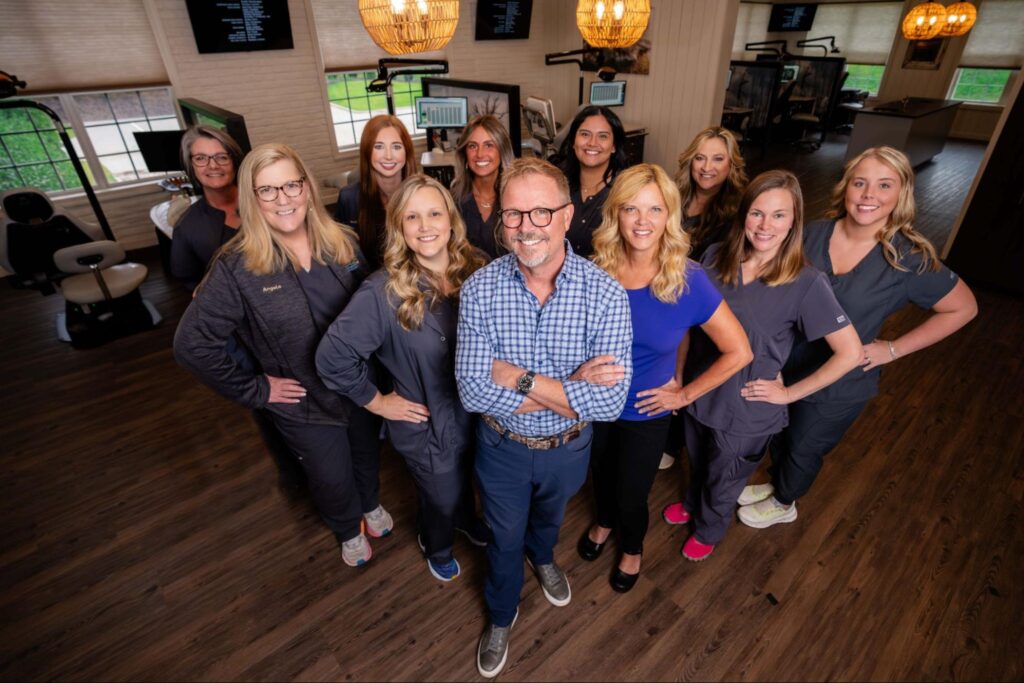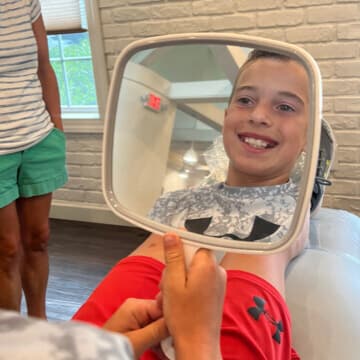Our Upstate Orthodontics team has what you need to fix dental crowding issues. If you’ve ever looked in the mirror and noticed that your teeth seem too close together, you’re not alone. Dental crowding happens when there isn’t enough room in your mouth for all your teeth to line up like they ought to. In many cases, you might see overlapping, twisting, or even some teeth pushed forward or backward. While it might feel frustrating, you have effective ways to deal with it. Dr. McInnis has offices in Clemson and Seneca that can give your teeth the care they need.
What Causes Dental Crowding?
Causes of dental crowding include the size and shape of your mouth, the timing of baby teeth, and extra teeth.
Mouth Size and Shape
One variable Dr. McInnis considers is the size and shape of your mouth. If you have a smaller jaw, there may not be enough space for all your adult teeth. Smaller jaws mean less room, which can lead to overlapping. Sometimes, teeth also grow in at an angle that nudges them out of place.
Early or Late Loss of Baby Teeth
The timing of baby tooth loss also matters. If you lose a baby tooth early, the adjacent teeth might drift into that open spot. That can rob the incoming adult tooth of a good place to erupt. If baby teeth hang around too long, the adult tooth might surface in an odd position, causing it to crowd others.
Extra Teeth or Impacted Teeth
Some people in Clemson or Seneca may have extra teeth, while others have teeth that don’t fully break through the gumline. Extra teeth often compete for room with your adult teeth. Impacted teeth may push existing teeth off course.
Why Crowding Matters
Like most orthodontic problems, crowding can cause other issues if our Upstate Orthodontics team doesn’t get to it in time. Here are a few things tooth crowding can lead to.
Oral Health Issues
Crowded teeth can affect more than looks. When your teeth overlap, plaque has extra places to hide. This can lead to a higher chance of cavities and gum issues. Dr. McInnis will tell you it’s also harder to clean in cramped spots with a toothbrush or floss.
Bite Problems and Wear
Crowding can throw off your bite. When your teeth don’t meet the way they should, you might put uneven pressure on specific teeth. Over time, that extra stress can wear down your enamel, which could raise your odds of pain or tooth damage later.
Confidence
You might feel more self-conscious about a crowded smile. Feeling unsure about your teeth can make you want to hide them. But the good news is that, with the right care from our Upstate Orthodontics team, you can enjoy a grin you feel good sharing.

Ways To Fix Dental Crowding
When you’re ready to address crowded teeth, orthodontic options can help. You can explore several approaches at our Clemson and Seneca offices, from metal braces to clear aligners like Invisalign. Each route has upsides, and your choice usually depends on your lifestyle, budget, and how much correction you need.
1. Metal Braces
Metal braces have been around for a long time. They remain Dr. McInnis’ tried-and-true solution for crowding, especially if you have more challenging tooth movements. Metal braces use brackets and wires. The brackets bond to the front of your teeth, and the wire stretches from bracket to bracket. Over time, the wire gently moves your teeth into better alignment.
Benefits of Metal Braces
- Durable and strong
- Works well for tougher cases
- Often, the most budget-friendly choice
Things to Consider
- Not as subtle as clear aligners or clear braces
- You’ll have to be cautious when eating chewy or sticky foods
2. Clear Braces
Clear braces from Upstate Orthodontics are similar to metal braces. But instead of metal brackets, we use tooth-colored or clear ones. They blend in more easily and can be a nice choice if you want the power of braces but feel self-conscious about the look of metal.
Benefits of Clear Braces
- Less obvious than metal braces
- Still very effective for major crowding
- Similar treatment time to metal braces
Things to Consider
- Clear brackets can stain if you aren’t careful
- May cost more than metal braces
3. Clear Aligners (Including Invisalign)
Clear aligners, like Invisalign, straighten your teeth without brackets or wires. They use custom-fit trays made of clear plastic to move your teeth step by step. Each set of aligners from Dr. McInnis is worn for about a week or two, then swapped out for the next in the series.
Benefits of Clear Aligners
- Almost invisible
- Removable for eating and brushing
- Often more comfortable on lips and cheeks
- Easier to clean your teeth
Things to Consider
- May not be best for certain severe crowding cases
- Requires self-discipline to wear aligners for the recommended amount of time each day
- Can be pricier than standard metal braces
4. Expanders or Other Appliances
If your crowding stems from a narrow jaw or issues with how teeth erupt, an expander might be part of your plan. An expander gradually widens the arch of your mouth, which could create extra space for crowded teeth to move. Our Upstate Orthodontics team might also suggest other tools, like spacers or rubber bands, to help create or hold space during treatment.
What To Expect During Treatment
Curious to know more about what happens during your treatment? Let’s look at our treatment process.
Your First Consultation
When you visit us in Clemson or Seneca for the first time, you’ll speak with Dr. McInnis about your concerns. We will take a look at your teeth, get some X-rays, and use 3D scans to map out where each tooth sits.
Regular Adjustments
You’ll check in for regular visits no matter which treatment you pick. If you have braces, Dr. McInnis will tighten the wires or switch out your bands. If you use clear aligners, you’ll get new sets of trays on a set schedule. These check-ins also let us track your progress and answer your questions.
Mild Soreness
As your teeth move, you might notice some tightness after an adjustment or when you switch to new aligners. It usually fades within a few days. Over-the-counter pain relievers and a softer diet can help you feel better during that stretch.
Keeping Your Smile in Top Shape
Once your teeth have settled into a straighter position, our Upstate Orthodontics team needs you to keep them there! That’s where retainers come in. You’ll likely wear one after your braces or aligners come off.
Questions You Might Have
Here are some common questions Dr. McInnis gets about tooth crowding.
1. Will I need any teeth removed to fix my crowding?
Not everyone needs an extraction. Sometimes, braces, aligners, or expanders can open up enough space. However, if your jaw is very small or you have extra teeth, the doctor might suggest removing one or more teeth. Our team makes this decision on a case-by-case basis.
2. How long does treatment usually take?
Treatment time in Clemson and Seneca varies from person to person. It might take a year or two for braces to do their job. Clear aligners can have similar timelines, but in mild cases, you may finish in less than a year. We can give you a more accurate idea once we see how crowded your teeth are and how quickly they move.
3. Am I too old for orthodontic treatment?
You’re never too old to improve your smile! Healthy teeth can shift at any age. Many adults wear braces or aligners today. Our Upstate Orthodontics team offers care for all ages, so you can jump in whether you’re 15 or 50.
4. How do I care for my braces or aligners during treatment?
You’ll need to brush carefully around brackets and wires if you have braces. Floss threaders or water flossers can help you reach tight spaces. Clear aligners should be rinsed or gently brushed each time you remove them. Always follow your orthodontist’s advice to keep your mouth as clean as possible.

Ready to Take the Next Step?
Ready to help get your teeth in the right spots? Go here to schedule your free consultation with Dr. McInnis at Upstate Orthodontics. We have two conveniently located offices in Clemson and Seneca.





